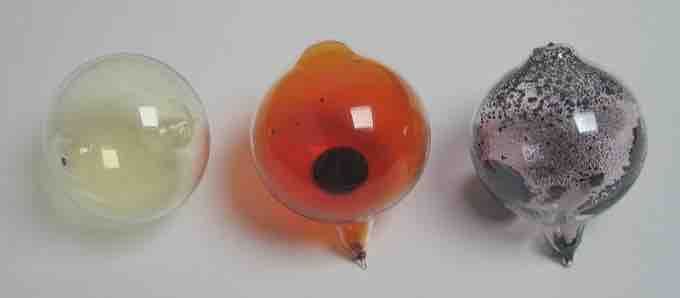The halogens are a series of non-metal elements from group 17 of the periodic table (formerly VII). The halogens include fluorine (F), chlorine (Cl), bromine (Br), iodine (I), and astatine (At). The artificially created element 117 (ununseptium) may also be considered a halogen.
Physical Properties
Atoms get bigger down the group as additional electron shells are filled. When fluorine exists as a diatomic molecule, the F–F bond is unexpectedly weak. This is because fluorine atoms are the smallest of the halogens—the atoms are bonded close together, which leads to repulsion between free electrons in the two fluorine atoms.
The boiling points of halogens increase down the group due to the increasing strength of Van der Waals forces as the size and relative atomic mass of the atoms increase. This change manifests itself in a change in the phase of the elements from gas (F2, Cl2) to liquid (Br2), to solid (I2). The halogens are the only periodic table group containing elements in all three familiar states of matter (solid, liquid, and gas) at standard temperature and pressure.

Physical States of Halogens
Halogens represents all of the three familiar states of matter: (left to right) chlorine is a gas, bromine is a liquid, and iodine is a solid. Highly reactive fluorine is not included in the picture.
Chemical Properties
Electronegativity is the ability of an atom to attract electrons or electron density towards itself within a covalent bond. Electronegativity depends upon the attraction between the nucleus and bonding electrons in the outer shell. This, in turn, depends on the balance between the number of protons in the nucleus, the distance between the nucleus and bonding electrons, and the shielding effect of inner electrons. In hydrogen halides (HX, where X is the halogen), the H-X bond gets longer as the halogen atoms get larger. This means the shared electrons are further from the halogen nucleus, which increases the shielding of inner electrons. This means electronegativity decreases down the group.
Halogens are highly reactive, and they can be harmful or lethal to biological organisms in sufficient quantities. This reactivity is due to high electronegativity and high effective nuclear charge. Halogens can gain an electron by reacting with atoms of other elements.
Fluorine is one of the most reactive elements. It reacts with otherwise inert materials such as glass, and it forms compounds with the heavier noble gases. It is a corrosive and highly toxic gas. Fluorine's reactivity means that once it does react with something, it bonds so strongly that the resulting molecule is inert and non-reactive. Fluorine can react with glass in the presence of small amounts of water to form silicon tetrafluoride (SiF4). Thus fluorine must be handled with substances like the inert organofluorine compound Teflon.
Fluorine reacts vigorously with water to produce oxygen (O2) and hydrogen fluoride:
Chlorine has maximum solubility of 7.1 g per kg of water at ambient temperature (21 °C). Dissolved chlorine reacts to form hydrochloric acid (HCl) and hypochlorous acid (HClO), a solution that can be used as a disinfectant or bleach:
Bromine has a solubility of 3.41 g per 100 g of water. It slowly reacts to form hydrogen bromide (HBr) and hypobromous acid (HBrO):
Iodine is minimally soluble in water, with a solubility of 0.03 g per 100 g water. However, iodine will form an aqueous solution in the presence of iodide ion. This occurs with the addition of potassium iodide (KI), forming a triiodide ion.